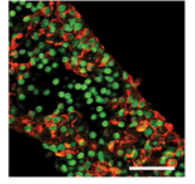A New Pathway to Beta Cells
Innovative process could increase beta cell supply for type 1 diabetes research and encapsulated cell replacement products
An important new technique to more rapidly convert human embryonic stem cells (hESCs) into cells similar to pancreatic beta cells was reported recently in Nature Biotechnology. In a study partially funded by JDRF, Dr. Timothy Kieffer of the University of British Columbia’s Diabetes Research Group and his research team used a novel seven-stage protocol to convert hESCs into insulin-producing cells. Previous conversion techniques were only able to produce beta cell precursors – not the actual final functioning beta cells – that take months to mature into insulin-producing cells.
The limited supply of islets or beta cells from human donors is a major hurdle for type 1 diabetes (T1D) research and the ability to replace islets in type 1 diabetes to restore insulin independence. This limitation slows down critical T1D research in many ways. Transplanted human islets have already enabled a small group of fortunate recipients to become insulin independent, but this life-altering therapy is severely limited by rare organ donations and recipients’ dependence upon the life-long use of immune-suppressive drugs.
The new discovery addresses some of the deficiencies of previous techniques by accelerating the production of insulin-producing cells. Following the study’s methodology, hESCs converted into nearly mature beta cells could provide a more reliable and potentially more cost effective cell source compared to the donated human islets or pancreatic progenitor cells using existing techniques. This could expand the number of islet transplantation procedures performed and increase the availability of human beta cells for research purposes. Once transplanted into mice, Dr. Kieffer’s insulin-producing cells corrected high blood sugar levels four times faster than transplanted cells derived using previous techniques because the new technique produces near fully functional cells whereas the old technique yielded less mature ones. The next challenge for Kieffer’s team will be to determine how to prevent the insulin-producing cells from being rejected by the body following transplantation and to find ways to scale-up the process to greatly expand the supply of these precious cells.
For more information or to support JDRF’s encapsulation research program, please click here.
Stage 7: functioning beta cells expressing insulin, which is colored in red.
